Related Research Articles
Edisto Island is one of South Carolina's Sea Islands, the larger part of which lies in Charleston County, with its southern tip in Colleton County. Edisto Beach is in Colleton County, and the Charleston County part of the island is unincorporated.
Hephzibah may refer to:
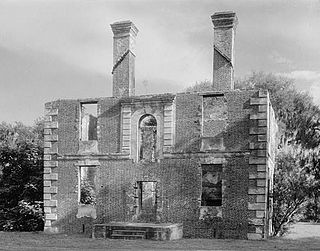
The Paul Hamilton House, commonly referred to as the Brick House Ruins, is the ruin of a 1725 plantation house on Edisto Island, South Carolina, that burned in 1929. It was designated a National Historic Landmark in 1970 for the unusual architecture of the surviving walls, which is partly based on French Huguenot architecture of the period.
Frogmore is an unincorporated community on St. Helena Island in Beaufort County, South Carolina, United States, along U.S. Route 21.

Ashley River Historic District is a historic district located west of the Ashley in the South Carolina Lowcountry near Charleston, South Carolina, United States. The Historic District includes land from five municipalities, almost equally split between Charleston and Dorchester counties. The district includes dry land, swamps, and marshes of the Rantowles Creek and Stono Swamp watershed.

Tabby is a type of concrete made by burning oyster shells to create lime, then mixing it with water, sand, ash and broken oyster shells. Tabby was used by early Spanish settlers in present-day Florida, then by British colonists primarily in coastal South Carolina and Georgia. It is a man-made analogue of coquina, a naturally-occurring sedimentary rock derived from shells and also used for building.
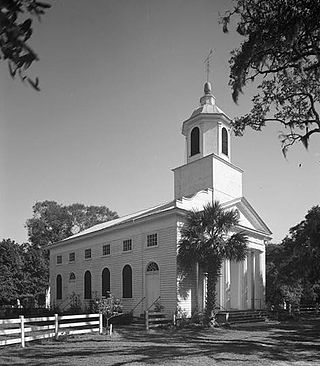
Edisto Island Presbyterian Church is a historic Presbyterian church on Edisto Island, South Carolina.

Botany Bay Plantation Wildlife Management Area is a state preserve on Edisto Island, South Carolina. Botany Bay Plantation was formed in the 1930s from the merger of the Colonial-era Sea Cloud Plantation and Bleak Hall Plantation. In 1977, it was bequeathed to the state as a wildlife preserve; it was opened to the public in 2008. The preserve includes a number of registered historic sites, including two listed in the National Register of Historic Places: a set of three surviving 1840s outbuildings from Bleak Hall Plantation, and the prehistoric Fig Island shell rings.
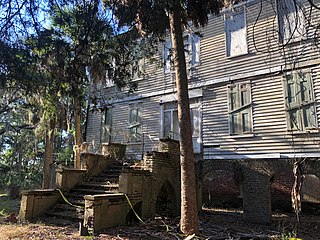
Peters Point Plantation is a historic structure located on Edisto Island, South Carolina. It was built by Isaac Jenkins Mikell in 1840 at the intersection of St. Pierre's Creek and Fishing Creek. It is located on the site General Lafayette used as a departure point from Edisto Island in 1826 during his southern tour.
Riverside Plantation Tabby Ruins is a historic archeological site located on Saint Helena Island near Frogmore, Beaufort County, South Carolina. The ruins are significant as an example of early- to mid-19th century tabby construction. The ruins are the remains of an outbuilding associated with the Riverside Plantation and have great archaeological potential.
Lands End Road Tabby Ruins is a historic archeological site located on Saint Helena Island near Frogmore, Beaufort County, South Carolina. The site contains the archaeological remains of a large late-18th to early-19th century house. The site has a tabby foundation pier and the partial outlines of a structure.

Sams Plantation Complex Tabby Ruins is a historic plantation complex and archaeological site located at Frogmore, Beaufort County, South Carolina. The site, possibly built upon and occupied well before 1783. It includes the ruins and/or archaeological remains of at least 12 tabby structures. They include the main plantation house, a rectangular enclosure consisting of tabby walls, a large tabby kitchen, and five tabby slave quarters. Also on the property were a variety of tabby dependencies including a barn/stable, a smoke house or blade house, a well/dairy house, and a well. The property also includes the Sams family cemetery and Episcopal chapel enclosed by high tabby walls. Other structures include possibly an overseer's house, a granary/mill, and a tabby cotton house. During and subsequent to the American Civil War the Sams Tabby Complex was occupied by freedman. Following the Civil War the plantation house was destroyed by hurricanes.

Spanish Mount Point is a historic archaeological site located at Edisto Beach State Park, Edisto Island, Colleton County, South Carolina. Spanish Mount is an oyster-clam shell midden, about 27 meters long and 3 meters high. The site is bordered by water and marsh on three sides. Spanish Mount dates between 2200 and 1800 BC and represents a transitional period of pre-history and the midden accumulated during the site's short term occupation.
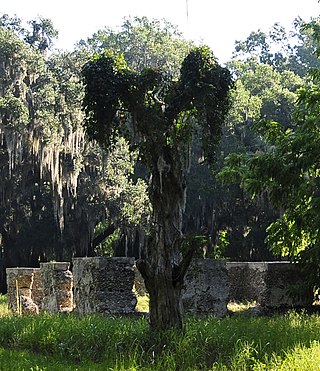
White Hall Plantation House Ruins and Oak Avenue is a historic plantation site located near Ridgeland, Jasper County, South Carolina. The site consists of the ruins of a brick house with tabby wings and twin tabby flanking outbuildings; a tabby retaining wall; and a massive double avenue of oaks planted in the late-18th or early-19th century. The plantation house was built between 1771 and 1776, then enlarged between 1786 and 1791. The house at White Hall burned about 1870 and was not renovated or occupied afterward.

Ashley Hall Plantation is a historic plantation complex located on the Ashley River near West Ashley, Charleston County, South Carolina. The plantation was established in the early 1670s by Stephen Bull. The property includes a small tabby-walled house with a 20th-century second story addition, the ruins of the Georgian plantation house (1704) which was burned in 1865 to prevent its destruction by Union forces, a monument to the second Governor William Bull, two prehistoric Indian archaeological sites, and two 18th century well sites associated with the plantation. The tabby house is considered one of the oldest standing houses in the state.
Paul Grimball House Ruins is a historic archaeological site located at Edisto Island, Charleston County, South Carolina. The stuccoed tabby house was built about 1682. In August 1686, the house was occupied, sacked, and possibly burned by the Spanish on a raid up the North Edisto River. The remains consist of a 12 feet high corner portion of a stucco covered tabby wall.

Wescott Road, also known as Westcoat Road, is a historic road located at Edisto Island, Charleston County, South Carolina. It represents the last undisturbed remnants of the main road on Edisto Island, and is an oak-lined dirt road approximately 2/5 mile in distance. The road was established in the Colonial era. This section was isolated when S.C. Highway 174 was straightened and paved about 1940.

Oak Island, also known as the William Seabrook, Jr. House, is a historic plantation house located at Edisto Island, Charleston County, South Carolina. It was built about 1828–1831, and is a 2+1⁄2-story, five bay, rectangular, central-hall, frame, weatherboard-clad residence with a projecting two-story rear pavilion. It features two, massive, interior chimneys with heavily corbelled caps and a one-story, wraparound hipped roof porch.
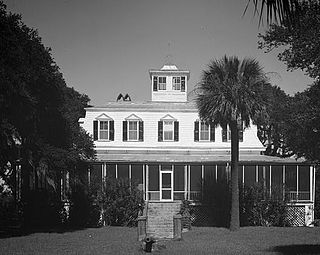
Sunnyside, also known as the Townsend Mikell House, is a historic plantation house located at Edisto Island, Charleston County, South Carolina. The main house was built about 1875, and is a 1+1⁄2-story, rectangular, frame, weatherboard-clad residence. It features a mansard roof topped by a cupola and one-story, hipped roof wraparound porch. Also on the property are the tabby foundation of a cotton gin; two small, rectangular, one-story, gable roof, weatherboard-clad outbuildings; a 1+1⁄2-story barn; and the Sunnyside Plantation Foreman's House. The Foreman's House is a two-story, weatherboard-clad, frame residence built about 1867.

The Callawassie Sugar Works is a historically significant industrial site at 29 Sugar Mill Drive in Okatie, South Carolina, on Callawassie Island in Beaufort County. The site contains the tabby ruins of two structures and archeological evidence of a third structure. The sugar works, constructed circa 1815–1818, was a complex for processing sugar cane into sugar.
References
- 1 2 "National Register Information System". National Register of Historic Places . National Park Service. July 9, 2010.
- ↑ unknown (n.d.). "Hephzibah Jenkins Townsend's Tabby Oven Ruins" (pdf). National Register of Historic Places - Nomination and Inventory. Retrieved August 3, 2014.
- ↑ "Hephzibah Jenkins Townsend Tabby Oven Ruins, Charleston County (Address Restricted)". National Register Properties in South Carolina. South Carolina Department of Archives and History. Retrieved August 1, 2014.

